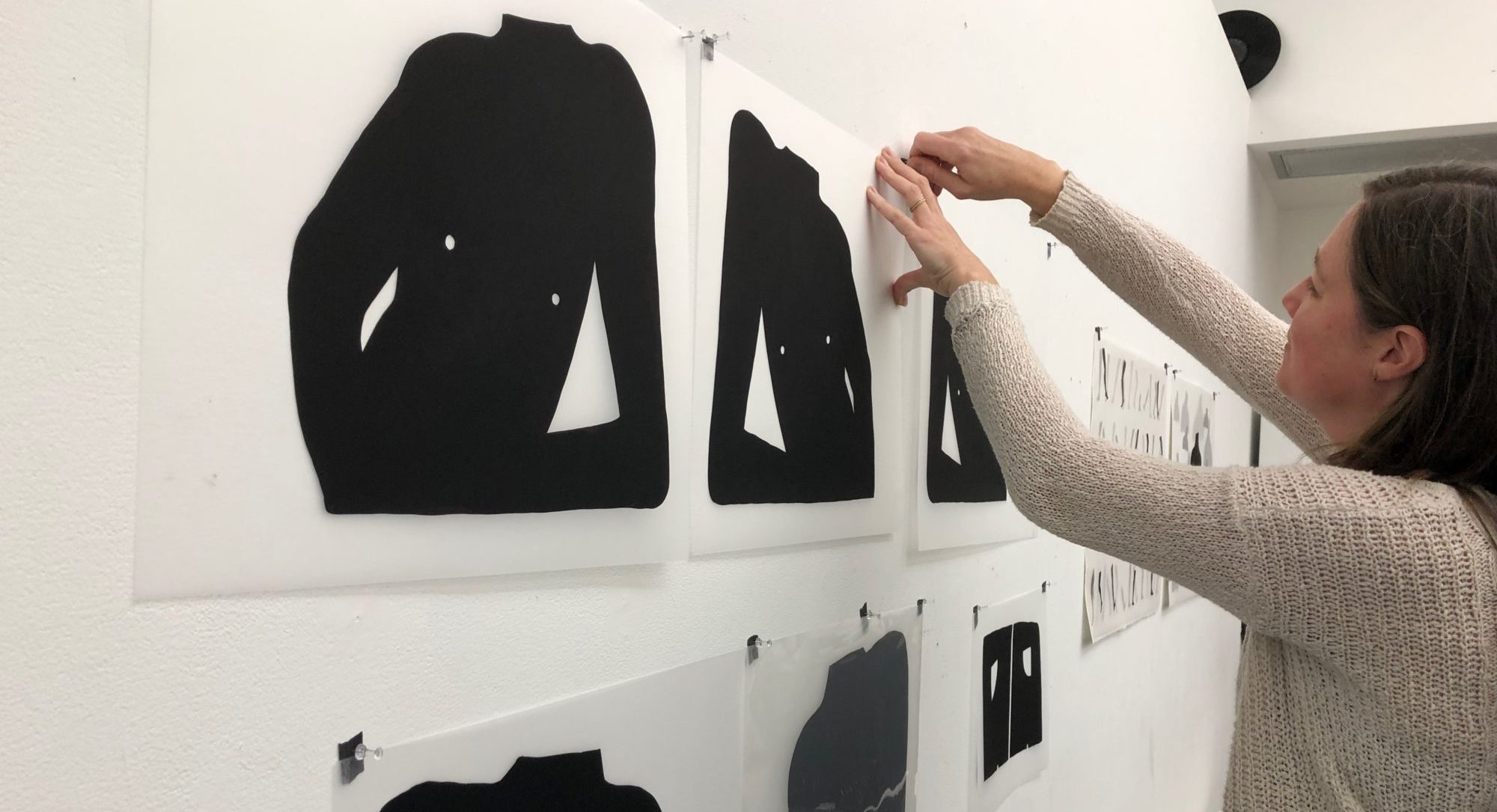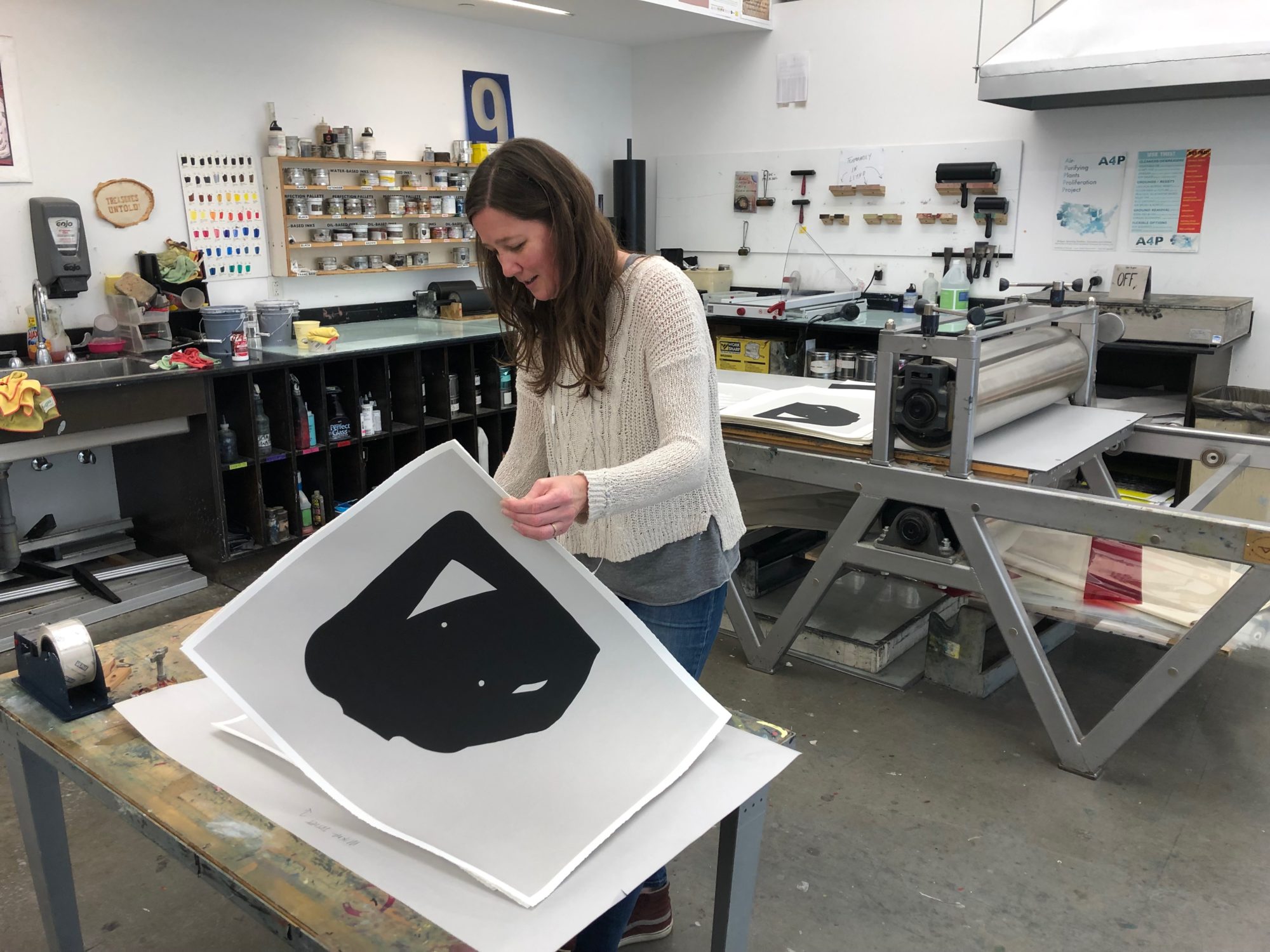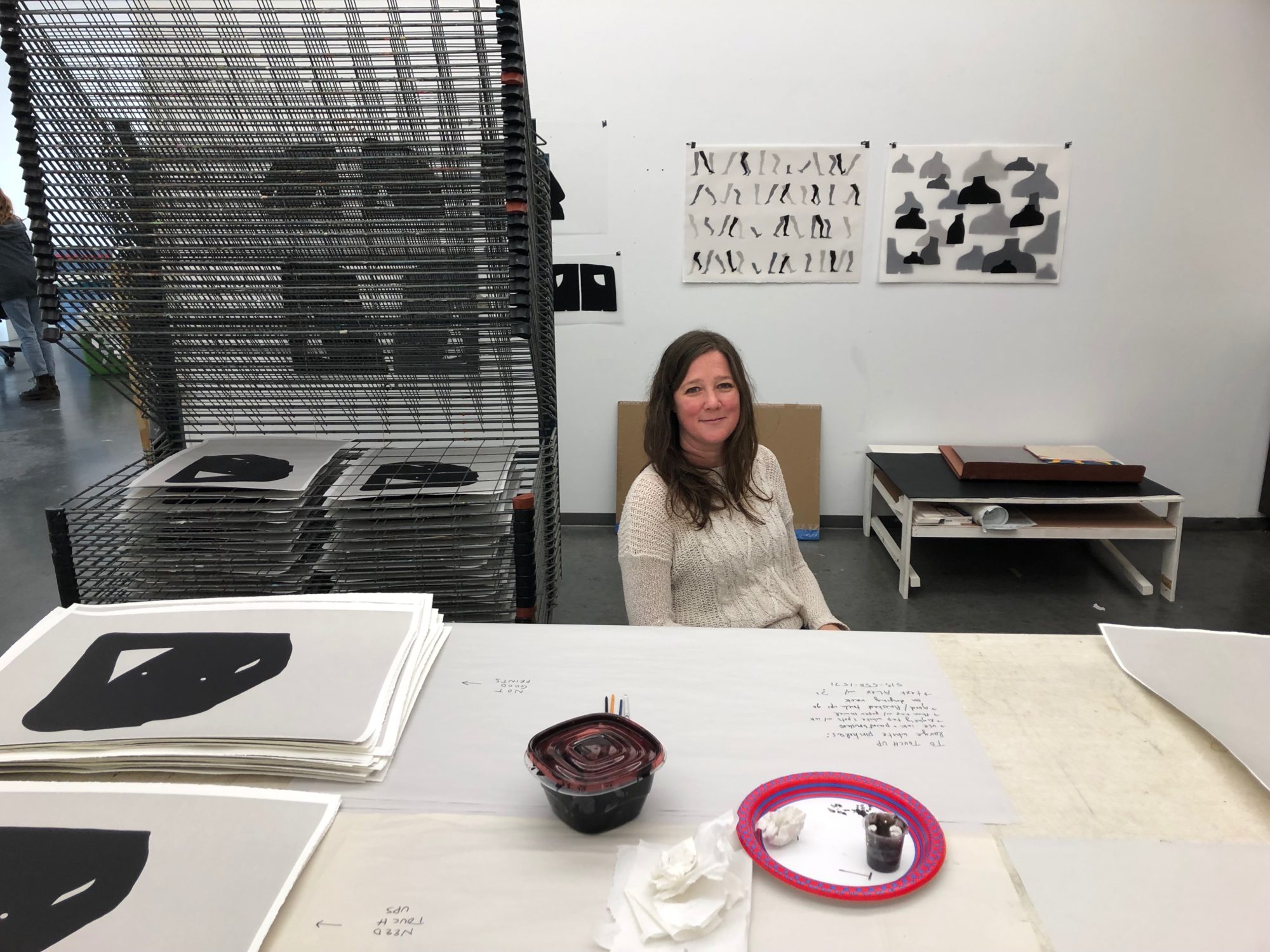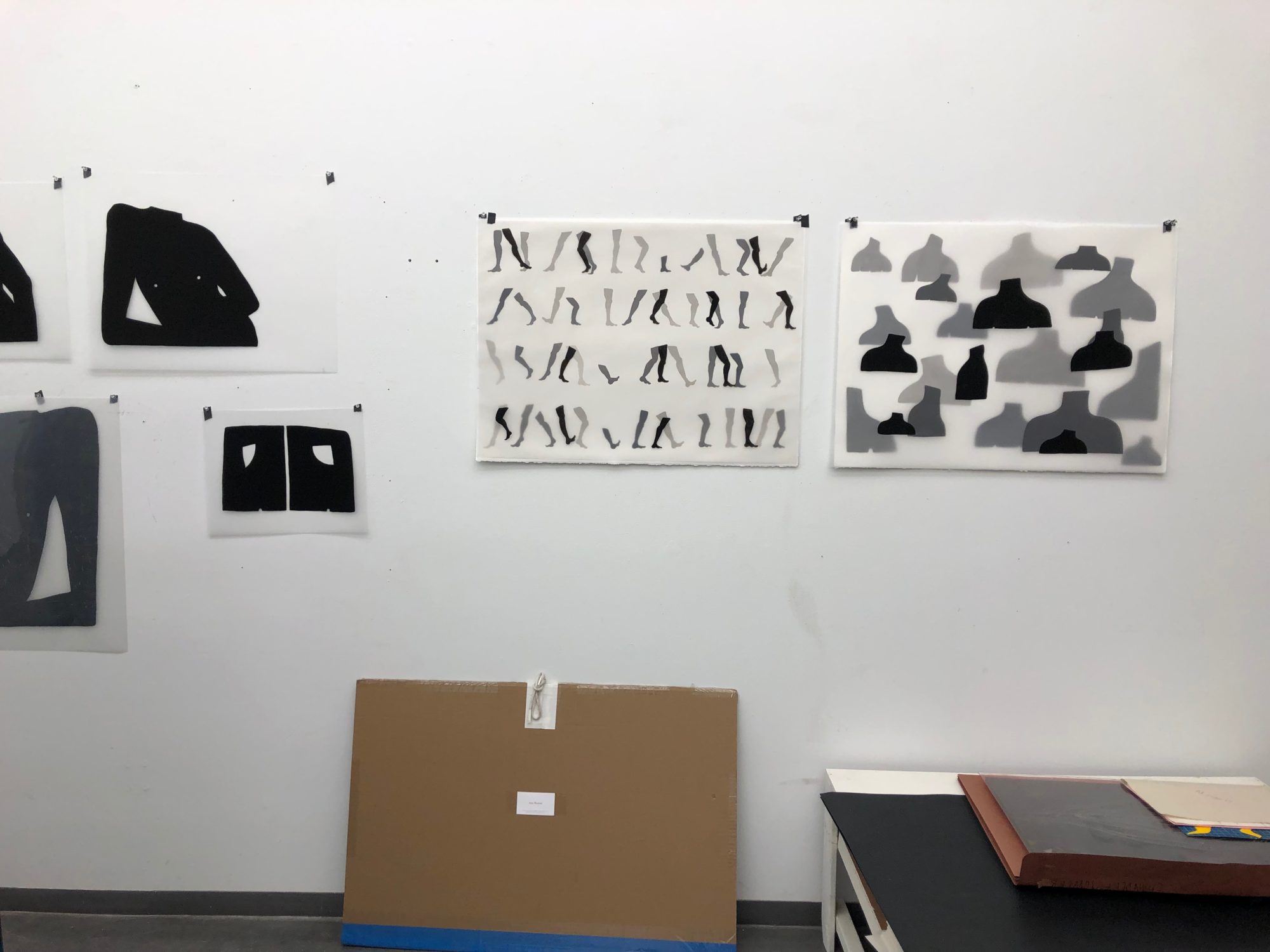Behind the Screen(print) with Amy Pleasant

All photos: Sarah Higgins
Share:
In late 2018, we reached out to artist Amy Pleasant and invited her to create an edition of prints for the 20th Annual ART PAPERS Auction. I caught up with Amy on the final day of a week-long visit to the University of Georgia’s Lamar Dodd School of Art. We sat down in the printmaking studio, in front of a luscious stack of Pleasant screen prints to talk about the process of creating the work, and the experience of her first venture into print editions.
Sarah Higgins: How long have you been here working on these prints?
Amy Pleasant: Since Sunday. Well, working in the studio since Sunday. So that’s five full days.
SH: Nice. And what have you been working on?
AP: I came to work on a single print, but because I was getting into town earlier than school started, [Associate Professor in Printmaking and Book Arts] Jon Swindler said, “Why don’t you come and use the studio on Sunday? Nobody’s going to be around. You can just draw.” And I was so glad he said that because I’ve never made a print before and it gave me an entire day to be in here alone and draw. I’m not familiar with the printmaking process. I’m not. You know, when you don’t understand how a print is made then you’re not really sure what you want to make. You’re not sure what those limitations are. So all day Sunday I was able to just come up with ideas and draw like I draw in my own studio, and then it was really all day Monday, because it was a holiday for the students too.
I was kind of the only one here for most that day and it wasn’t until probably the end of the day that I started to realize how it would all come together. Drawing on frosted Mylar, layering it on the paper and staining the paper and, you know––that similar to the process I have in my own studio, when I’m making my drawings. It’s like staining a paper with a shade of ink wash, which is how we ended up picking the screen print color. We pulled what I learned is called a flat, which is basically pulling a solid color onto the paper and then the image can be layered on top. Jon said, “We want you to just do what’s natural. You don’t have to worry about the other stuff. Just come in here and do what you do. And then we’ll come up with a plan.” So that was awesome.
SH: I’m really surprised to hear that you’ve never made a print edition before. Your work seems like it would lend itself really well to almost any type of printmaking. How is it possible that you’ve never made an editioned print before?
AP: [laughs] I know everybody has said the same thing and I have had multiple conversations with printmakers about doing that. And it’s just that certain opportunities haven’t come around. But I did work with one printmaker at Auburn University to create a relief print, and that experience kind of got the bug started. We never got really deep into it because I was there as a visiting artist, just giving a lecture, and I had an exhibition. It was Andrew Kozlowski. He’s not at Auburn anymore, but he wrote to me and said, “You know, I think it’d be really fun to play in the print studio if you’ve got a little bit of time while you’re here. Come in and play with the students.” So I sent him drawings before I got to town. He cut them out on a laser cutter and then we basically did a relief print where the students would ink them up and then I would get to lay them on the bed. It was so much fun, and we’d just gotten started and time was up. We got a couple of artist proofs pulled, and we’ve always had a plan to work together again. Hopefully that will happen at some point. When it came up to make a print with Art Papers, I was thrilled to get to do it.
SH: That’s awesome. We’re so glad! My own background is in printmaking––that’s what my undergraduate degree was in––so I look at your work and see a natural fit. I also was fantasizing, sitting in the office when I first heard you were doing this edition and imagining, okay so, her work would make a beautiful intaglio print. It would obviously make a beautiful lithograph. It would be really, really gorgeous as a relief print. Obviously, that would work really well. And also like, oh! It could be a really beautiful screen print. And I was trying to imagine all the subtle ways that it would be different and translate into those different kinds of process.
AP: Exactly, yeah.
SH: So, how did you arrive at doing a screen print?
AP: Well, the image that we decided to do for Art Papers was a large, very flat image. We just really felt the screen print would reflect that flatness that I get in my works on paper. And we wanted it to relate as much to my other works on paper as possible. And what was nice, too, was pulling the flat screens. I liked how it is very similar to me staining each piece of paper that I draw on, and that’s a big part of the process for me because every ground is a little bit different. And what I learned is that even pulling the flats from the silk screen, each one is different. Based on the pressure that you use or how much ink is on it or the drag or whatever. And so it’s still that unique object, like a drawing. It was just the perfect translation, and the plan was that we would play around with some other techniques while I was here, do a little letter press something, and we ran out of time, but it’s in the future.
SH: Yeah, I certainly hope that this is the start of something.
AP: Yes.
SH: Good! I know that you had a lot of assistance from UGA students and faculty. Tell me about what the experience has been like working in the studio.
AP: I always knew that it was a collaborative kind of process, but I didn’t realize just how collaborative printmaking was. And it was so great when we really started pulling the prints. Jon pulled all the prints and two students helped place and remove paper. So, one placed the paper, one pulled the ink, and another pulled the print off and put it on the drying rack. Every single person was so hands on and had their eyes on each part of it because you know, it’s a very precise activity. And there were so many points at the beginning where we had to troubleshoot some issues that were going on. And at one point they came into the second room to have a little sigh and talk about it. Each person kind of gave their opinion on “well maybe if this was a little closer to the bed, or maybe if we used a different squeegee, or maybe there’s a little too much water.” And it was so interesting. They were all together problem solving, and then they all go back to the table and make it happen. And it’s a really cool thing. They rely on each other in a way. I’m sitting there thinking, “Wow, when I go to my studio I’m completely alone.” But it’s really cool. They’re a real team.
SH: I think often when folks first stick their toes into printmaking it’s doing one-off things, or tiny series with variations, or playing with what are ultimately monotypes. And you know… there’s a moment where you transition into editioning and suddenly it gets very serious.
AP: Right! Yeah.
SH: And for a lot of people, the repetition of creating an edition is where they are no longer interested. Especially artists who are making prints as sort of a break out of their normal processes. But the way your work has this relationship to repetition, to, you know, to a form appearing and reappearing and being slightly altered… Do you feel like the edition part was good for you?
AP: Yeah. Yeah. And then for a lot of those reasons just recognizing the difference and trying to literally recreate something again and again and again and again. And realizing, you know, every single one is going to have a different… It’s gonna have errors, if you want to call them that. But it’s our human touch, and that’s one of the beautiful things. That’s why people still handprint things instead of working on computers and printing them out because even though you’re recreating the same thing, it’s not the same thing every time. And I think that’s really beautiful.
SH: Yeah, suddenly there’s the goal of reproducing every piece as true to the standard as possible. And yet there’s also this kind of inevitability of minute differences within that. I always found it really satisfying.
AP: Yeah exactly. I do too. I think it’s kind of beautiful.
SH: The accident moments are different when you’re actually, really making a concerted effort to make them all the same.
AP: Right! [laughs] No, it’s so true.
SH: Was there something you found yourself surprised by, or thinking about while you were doing it?
AP: It really is wanting to do more. It would be so cool to see how different the same image would be on a letter press or doing some sort of aquatint… And then building the layering. Until I start doing something, I don’t really understand it, and then it’s like, “oh I could do that!” You know, and then that’s the tip of the iceberg.
SH: Well I’m really excited to see this edition go into the world.
AP: I know. Me too.
SH: One of the things that I’ve always loved about printmaking is that it allows you to make work accessible to people that love it but may not have the means to collect larger works.
AP: Exactly.
Amy Pleasant’s edition will be available for sale to Auction VIPs on Feb. 28, and the general public on March 2. You can view the print here.


